Secure all breakable objects, it's The Coming Storm!
The show I’m looking forward to most at this year’s Avignon Festival is Forced Entertainment’s The Coming Storm. The title seems apt as what we can expect from this show is turmoil - a ripping up, clashing cross-currents and a form of destruction - that by the end will leave us seeing things with new eyes.
In a more literal sense, The Coming Storm does also include a lot of branches. Among these branches are woven many stories: stories that tail off, stories that contradict themselves, stories being performed on the stage that are not those being spoken by the performers. Added to this is music, dark humour, and sudden visual moments of a captivating beauty.
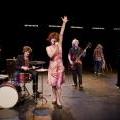
Tim Etchells is the Artistic Director of Forced Entertainment, the UK-based company which was formed in 1984 and which has performed its anarchic theatre from Beirut to Bogota, Serbia to Singapore, and will this month be in Avignon. What is central to the company’s work is their constant questioning of theatre and performance: what it means, its relationship with the audience, and how to break it up to better put it back together again. Etchells quotes fellow performance-maker Matthew Goulish: “If you want to study a system, first look at how it fails.”
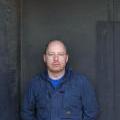
Undeniably Forced Entertainment produces work which challenges its audience, in which an element of the uncomfortable, the difficult, is always inherent – and of which Etchells refuses to let go. “I ask of each performance: will I carry this event with me tomorrow? Will it haunt me? Will it change you, will it change me, will it change things? If not, it was a waste of time.”
I spoke to Tim about The Coming Storm and the company’s forthcoming visit to Avignon, and he told me about loud drum music and the unforeseen virtues of giving up.
KF: Is it possible to describe the form of the show?
TE: In one sense it’s a series of stories that are told by different performers, but the stories are quite violently interwoven with each other and interrupt each other, and very often the stories are abandoned before they’re finished, or they become slightly confused or embroiled with each other. It’s six performers and begins with a section where Terry, one of the performers, is talking about what makes a good story – and then almost all of what happens after that is that people make a series of propositions for what a good story might be, most of which are kind of ridiculous or slightly wrong-headed in different ways; and at the same time two other things are happening, one is that people in different ways are somehow making things happen in the space that maybe illustrate the stories but often don’t really illustrate the stories, and it’s more like another story’s coming in from somewhere else. It’s more about people changing costumes and about dancing or about behaving in strange ways so you get this kind of friction, if you like, between the stories that are told and the stories that are happening in the space.
And then the third element is music: adding sound and music from piano, guitar, bass, drums and again sometimes it’s supportive of the stories so you feel like a helpful atmospheric contribution is being made, but very often it’s disruptive… I mean for example the drums are the main instrument at various points and it’s very unhelpful to have someone drumming while you’re trying to tell a story, but the cohesion of these things becomes something new, it becomes part of the texture, but it’s also kind of comically disruptive if you like.
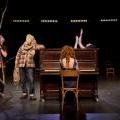
KF: And do you like being about to disturb your audience or leave them a bit wrong-footed like they’re not really sure what’s going on?
TE: Well yeah I think we like to play on that border of what’s coherent and what’s incoherent, and I think there’s a delight in that which is to do with, as an audience member, trying to make connections between one thing and another, where the connections aren’t really fully formed or really clear, but you can see something’s going on. And in a way that makes your role as a viewer very active because there’s still work to do. What the shows don’t do is lead you carefully down a path and say here’s this and here’s this and here’s this: you’re sort of thrown in to a confusing space and left to fend for yourselves. But I think we’re very careful as well to… if it becomes incoherent or slightly crazy for a while there will be a moment where things seem to calm and where there’s a different kind of focus.
KF: Have you had audience members that really don’t get what’s going on and have they reacted in a certain way, what’s the strangest or most gratifying reaction you’ve had?
TE: A response that we used to get years ago and which I still hear occasionally is people saying: I didn’t really get it, I didn’t really know what it was about… and then I gave up and I really enjoyed it (laughs). And there’s something about that giving up that’s interesting. But of course we get both ends of the spectrum, we get people who are massively enthusiastic about the work and they love that space that it puts them in, and that sort of responsibility for their own watching that they have, and we get people who don’t like that, and they feel like they don’t know where they are, and they’re bored… it happens. It’s not unusual that somebody walks out, for us, but… after 27 years this is fine for me and I’m really not unhappy if some people decide they’re going to leave… I prefer it’s not many-
KF: Not the majority?!
TE: Yeah, I don’t like to lose everybody(!) That’s fine, the work has got a kind of challenging aspect to it and I know that some people think, actually it’s not for me.
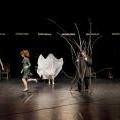
KF: I can see that you recently performed The Coming Storm in a miners’ shower room [in Essen]. At Avignon you’ll be in the Salle Benoit XII, what’s that like in comparison?
TE: On the whole we tend to up in more or less theatre spaces, and that can mean anything from… Essen, where we opened the show, is a former coal mine, and it’s a huge white-tiled space, massive, and they black-draped it so it was basically a black box, but it’s got this very functional, rather characterless feel as a theatre space… and then the next gig on the tour was a state theatre in Braunschweig, a traditional proscenium arch space. So we tend to go from these very functional black box spaces to very golden proscenium arches with red velvet seats and all that kind of stuff… and basically everything in between, and the work has to find a way to operate in all those different kinds of spaces, and of course it’s very difficult: we were just at Battersea in London in the BAC, we were performing in the great hall of the former city council building, town hall building in Battersea, and it’s a very grand slightly crazy architecture, which we didn’t hide because it’s too ugly to hide so it ends up being a very very strange space.
This space [in Avignon] which we chose is slightly run-down sort of proscenium arch, raised stage, slightly faded… it’s charming in a slightly dilapidated way and that’s something that appeals to us I think, so we like a space that’s got some kind of texture in that way.
KF: Does the show develop bit by bit with every performance, or do you adapt it in some way for each place?
TE: Basically we’re working on the idea that it’s fixed, it’s generated through improvisation, huge amounts of pretty much open scenes and whatever happens let’s see what happens, exploration, very open… and then at a certain point we will begin to try to fix in things. So for example in London just now, the pressure was on to get the text translation done for Avignon because that has to be surtitled and at that point we’re really going, It has to be these sentences in this order, not to enclose that … because naturally the performers they make a lot of the material in improv, they own it, and they’re very happy to sort of do something “roughly like what we said”, but obviously with the surtitling you can’t do that… so for Avignon it’s going to be pretty…
KF: Fixed?
TE: That’s what we’re saying, yeah…! (laughs)
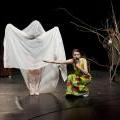
KF: What’s your best experience been at Avignon, what do you like most about the festival itself?
TE: Well I went last year to take part in Boris Charmatz’s Musée de la Danse project in the Ecole des Arts, where I had a small modest visual arts project to do with collecting […] a kind of weird incomplete fragmentary museum or encyclopaedia of what dance and movement might be. So yeah it was the first time I’d been and I actually really liked it. I haven’t been much to Edinburgh either, I’ve been a couple of times just to see Pina Bausch and then just run away, but it’s not in my heart to really enjoy this kind of environment. I’m a bit sceptical about these kinds of things and I don’t like to see people in costume and in the streets too much... and like the atmosphere of it. I went to see a great thing, I was there for the opening of Boris Charmatz’s Enfant piece, in the Pope’s Palace, and I thought that was one of the most extraordinary things that I’ve seen in the last 10 or 15 years, it really completely blew me away. I think that they’re running a really interesting programme now, and so I’m kind of excited, not just to show The Coming Storm, but also just to be there and to see other stuff.
.jpg)
KF: Do you have any advice for people visiting Avignon for the first time?
TE: I’m terrible at doing those things… I was looking at the main festival brochure, just pick some choice things and book things as you can. For the rest, I mean the Fringe is kind of massive, there are just so many shows, the whole town just gets taken over with posters. I don’t know if you’ve seen images of it during the week [looks for photo] it’s crazy how it looks, people just plaster every surface of every wall with posters, there’s so much stuff happening. But you know it’s a nice atmosphere, it’s beautiful, and the weather’s great.
And at this point we both laughed in the unspoken knowledge that, at the moment, the weather is categorically not great at all. But the theatre will be, and that’s what counts.
The Coming Storm will be at Avignon 19th – 27th July, and there are still a few tickets remaining. Forced Entertainment will also be showing the late-night All Tomorrow’s Parties in the Ecole des Arts (22nd – 24th July), and Tim’s own exhibition of photographs which he’s been working on since 2003, Empty Stages, can also be seen throughout the festival.
http://www.festival-avignon.com/en/Reservation


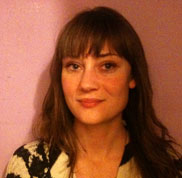
1 Comments
Post new comment